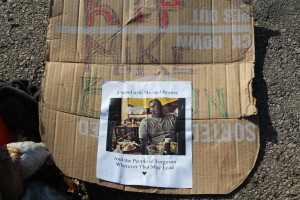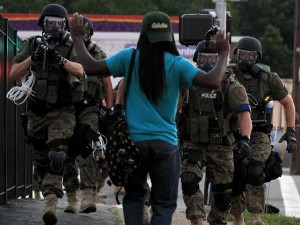Ferguson: Communicating During the Chaos
Posted: April 28, 2015, 2:50 p.m.
by Laura Gregory and Sarah Parker.
For the past six months, debate has raged regarding police brutality and race relations. At the center of this issue is Ferguson, Missouri, where an African-American 18-year-old was shot and killed by a white police officer. In the days that followed, intense civil unrest ensued. That discontent continued to elevate and culminated when the grand jury announced its decision to not indict police officer Darren Wilson for the shooting of Michael Brown.
 Many people were visibly upset with how the Ferguson police department appeared to handle the situation — immediately following the shooting, in subsequent weeks and after the grand jury released its decision — and eventually that frustration with police grew into a national issue. Much of the discontent was tied to the crisis communications coming out of Ferguson. By the time key parties responded, the incident had already taken over social media and the community had taken to the streets in protest.
Many people were visibly upset with how the Ferguson police department appeared to handle the situation — immediately following the shooting, in subsequent weeks and after the grand jury released its decision — and eventually that frustration with police grew into a national issue. Much of the discontent was tied to the crisis communications coming out of Ferguson. By the time key parties responded, the incident had already taken over social media and the community had taken to the streets in protest.
The social media response
The night of the incident, a Twitter user named @TheePharoah had a view of the street on which the incident occurred from his apartment, and tweeted (Warning: Graphic) what he saw. This erupted over social media, with no immediate response from key parties in Ferguson. Additionally, “[w]itness accounts spread after the shooting that Brown had his hands raised in surrender, mouthing the words ‘Don’t shoot’ as his last words . . .” according to the Washington Post. Both of these incidents fueled the intense demonstrations that night and in the following days.
According to a different article by the Washington Post, the morning after the shooting St. Louis County Police Chief Joe Belmar announced what was believed to have transpired between Wilson and Brown (link). By that time, however, the nation had already seen the coverage of the rioting and demonstrations, and the outbursts on social media.
Gerald Baron, president of Agincourt Strategies LLC, said one of the problems with the Ferguson police department’s response was that it was too little, too late because at first, there was only one story being told: the Twitter story.
“My perspective on this is that there are two very different explanations for what happened in this shooting,” Baron said. “One of them was what some people who were nearby either assumed or saw, or just saw partially. One of the most significant was this Twitter user who lived in an apartment and could see everything clearly. He said some things [on Twitter] immediately after, and that was how the story went out.”
Denise Bentele, president and CEO of CommonGround Public Relations — the firm hired to field media queries for the city of Ferguson — agreed that Twitter fed a false narrative to the public.
“The real issue with crisis communications, in this modern era when you have civil unrest, is the speed at which negative and false information gets out. That’s what we as communicators need to ultimately build better systems for: capturing that information, monitoring that information, establishing ways to communicate truthful information and creating a network of organizations that are responsible for communicating in a cooperative manner.”
She said it was difficult for key parties to respond when those in charge didn’t immediately know all the facts. As the police were learning what had happened that night, #Ferguson was already trending on Twitter “with tweets loading faster than phones could take it,” Bentele added. The response on social media was overwhelming, with many of the tweets filled with falsehoods and “hatred.”
In that situation, Bentele said that “[s]ome of the banter has to be ignored because it takes too much energy away from the truth and the positive, helpful information,” which may seem counter-intuitive to crisis communicators who want to dispel every single negative, inaccurate tweet or post.
“That hatred on Twitter, in particular, doesn’t even want to be corrected; it’s part of a whole secret, private and anonymous frenzy that we as communicators are going to have to plan for and be prepared for going forward, because the traditional way of handling a crisis is to respond to everything, be ready and present all the time.”
Bentele discussed how a lack of continuity in responses throughout the initial timeframe after the shooting contributed to frustration, and how important a unified response is from all parties involved.
“A unified response is always what you want in a situation like this,” Bentele said. “Before you encounter a crisis, communities and municipalities should ask ‘what can we be ready for, and who and how are we going to get together to put forward a unified response, and address human needs as well as external communication needs’.”
The city of Ferguson response
Bentele explained that the city was caught unprepared for the hundreds of media calls they received each day, which was amplified when they lost connectivity completely. Her firm was responsible for creating and manning specific lines of communication between the city of Ferguson and the media, such as a phone line and e-mail address dedicated to media inquiries.
“A lot of the initial queries and responses required helping media connect the dots: because of the many jurisdictions, we had to help get reporters to the right authority (city, county, or state) and then handle Freedom of Information Act requests,” Bentele said. “The media have a right to enter FOIA requests, and it is incumbent on the city to respond in a timely fashion. So building a mechanism to handle these queries is essential and was a large part of what we did in those few days.”
Bentele said there are steps local, city and state governments can take that will assist in minimizing frustration should a crisis like Ferguson occur.
“They should troubleshoot these sorts of major disasters, in this case human tragedy, to handle the communications. They may not know what the issue or messaging will be, but at least how they will logistically handle resources, whether it’s an external public relations firm or having back-up technology ready,” Bentele said.
Baron also provided some guidelines that are critical to proper communication in a crisis.
“If the accusation is true, your response is to admit it, accept responsibility, apologize, demonstrate your concern for the people affected by your bad behavior, and explain what you’re going to do to fix it so it doesn’t happen again,” Baron said. “If it’s false, then you have a great obligation to explain why it’s false, what the truth is and to be fully open and honest about it, but to correct the misinformation as quickly and thoroughly as you can.”
Erik Bernstein, vice president of Bernstein Crisis Management, said that “Considering the many, many lessons learned since that fateful day in August, there is potential for crafting one of the best crisis management plans in the nation.”
 The latest
The latest
A new crisis has put Ferguson in the spotlight once again, and provides insight into what key parties have learned and changed concerning their crisis communications.
On May 12, two police officers were shot during a protest outside of the police headquarters by 20-year-old Jeffrey L. Williams. The purpose of the protest was to support major reforms in Ferguson. However, in a turn of events, the shooting resulted in a show of support for the city’s police force, although it was met with opposition.
U.S. Attorney General Eric Holder is quoted in an article saying, “[Williams’] arrest sends a clear message that acts of violence against our law enforcement personnel will never be tolerated.”
Bernstein said that based on his tone and content of the communications, it is likely that Mayor James Knowles is being advised by a PR firm or counsel of some sort. He also praised St. Louis County Police Chief Jon Belmar.
“[Belmar] has conducted several recent press conferences, including the one that followed the shooting of two officers in front of the Ferguson Police Station,” Bernstein continued. “He’s still ventured into some dangerous territory in terms of wording, but overall his communications have been much more effective than others.”
There is no denying that the city of Ferguson is dealing with a crisis on a grand scale. The nation has its eyes fixed on the city, waiting to see what its next move will be. However, Ferguson is just one example. There are racial biases and issues facing cities and police departments across the county. Bernstein highlighted one key lesson that those cities, such as New York City or North Charleston, South Carolina, should look to when figuring out how to handle their own crisis.
“The no. 1 lesson to be taken from this is that you can’t lose sight of the fact that you’re dealing with your fellow humans. Every potential action needs to be viewed from the vantage point of those affected, and empathy absolutely must play a major role in your minute-by-minute handling of any crisis situation,” Bernstein said.




